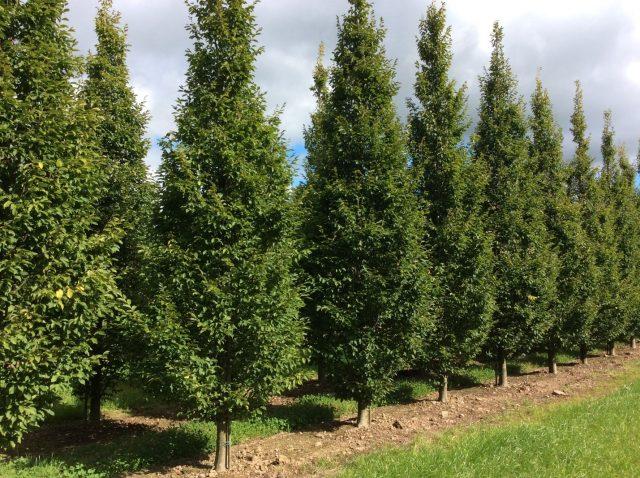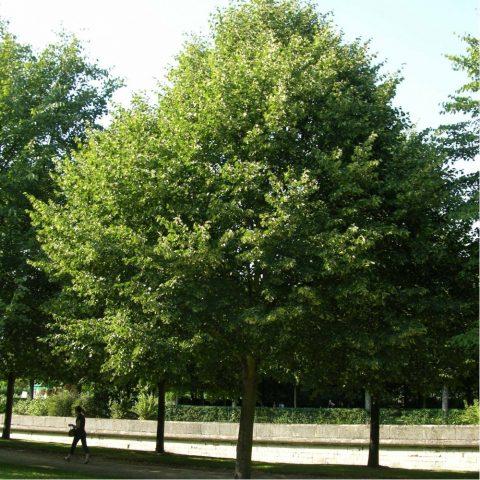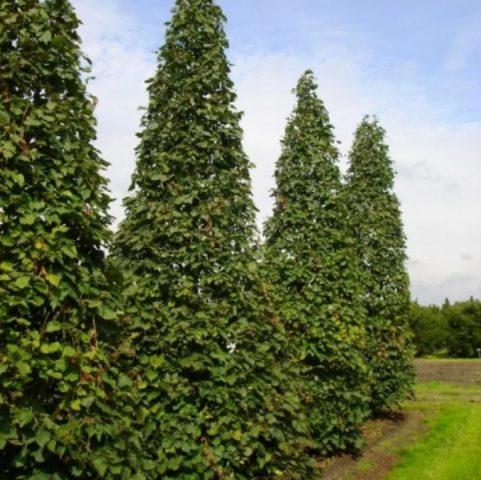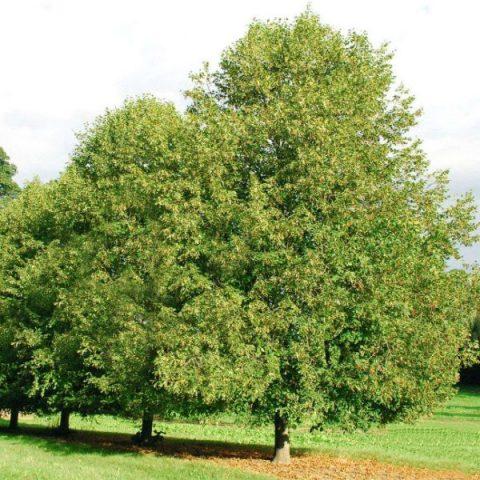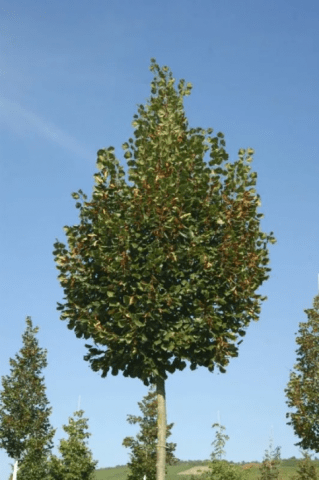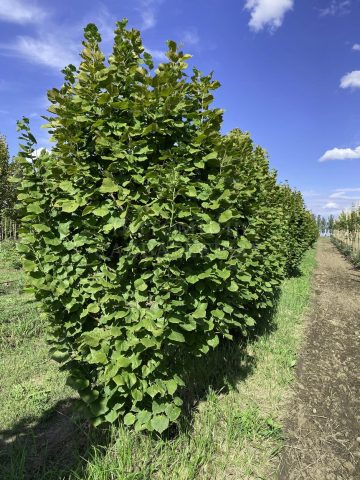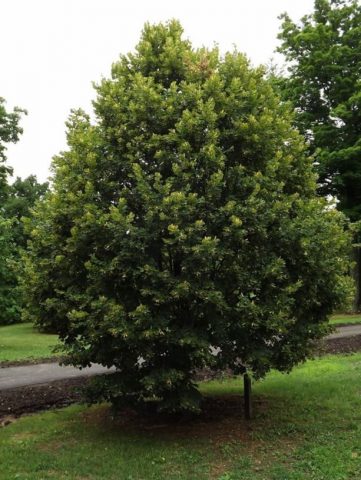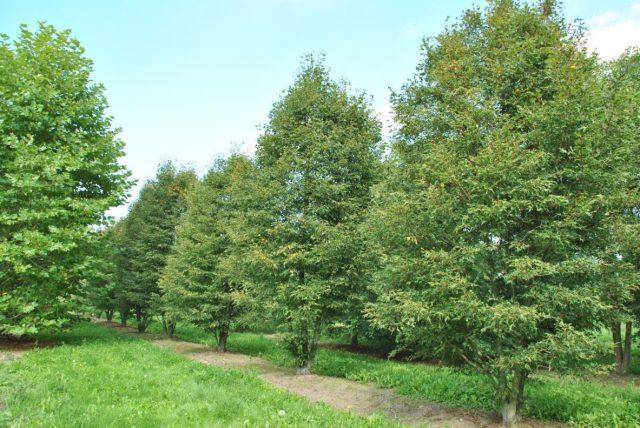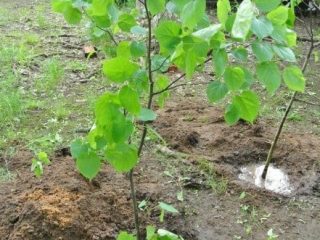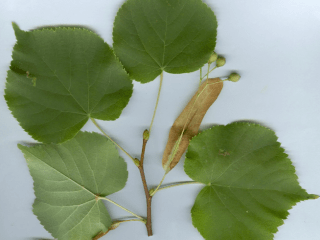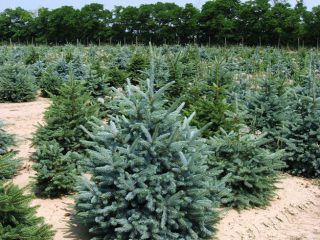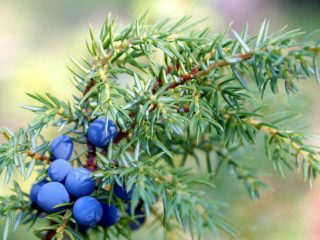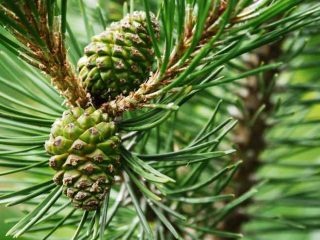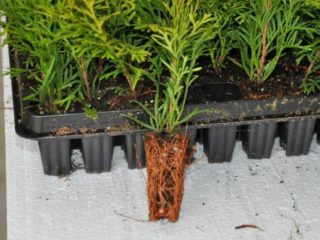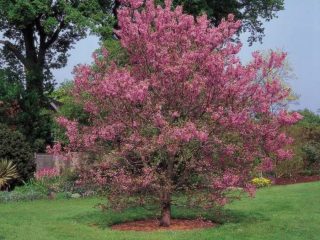Content
Due to its size, large-leaved linden is rarely found in private plots, but it is consistently in demand by landscape designers for landscaping public areas. The plant is unpretentious in care, easily fits into landscape compositions in different styles, successfully adapts to the urban atmosphere, and is rarely affected by diseases and pests.
Description of large-leaved linden with photo
Large-leaved linden (Tilia Platyphyllos), also known as “summer”, “broad-leaved” and “flat-leaved”, is a deciduous tree from the Malvaceae family (Malvaceae). Until recently, it was listed in the family of the same name, but now Linden trees have been abolished from the official botanical classification.
Height of large-leaved linden
The height of the tree in nature reaches 40 m. Selected varieties of the crop are inferior in size to the original. They rarely extend higher than 20-25 m upward.
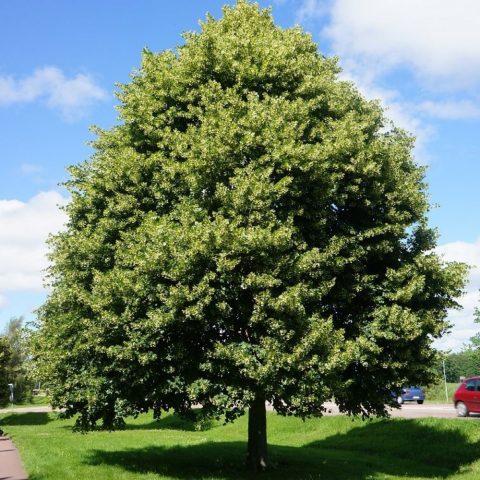
The above-ground part is balanced by a powerful root system
Diameter and shape of the crown of large-leaved linden
The crown, even in natural conditions, without outside help, is quite symmetrical and broadly pyramidal. As the tree ages, it becomes rounded and arched. Diameter – within 18-25 cm.
The shoots are pubescent, densely leafy, the shade varies from reddish-brown and brick to coral. In winter they look spectacular against the background of snow.
The name, large-leaved linden, is obviously due to the size of the leaves. They reach 14 cm in length, the shape varies from round-ovoid to heart-shaped.
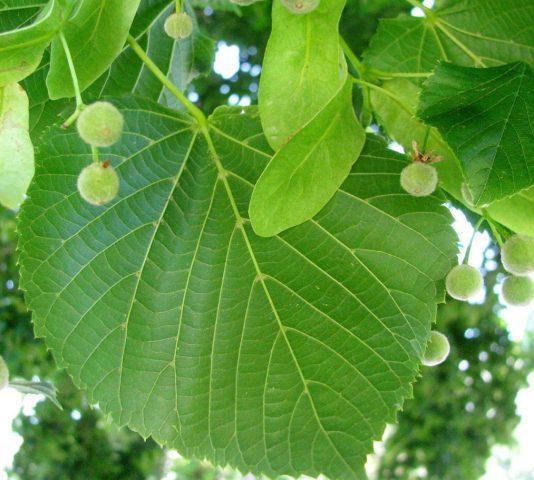
On top the leaf plates are a rich dark green hue, the underside is much lighter
The flowering is abundant, the leaves in the crown are almost invisible. The flowers are five-petaled, collected in loose inflorescences of 2-5 pieces, the petals are yellowish-cream. Flowering occurs in the first half of June. The fruits ripen in early autumn.
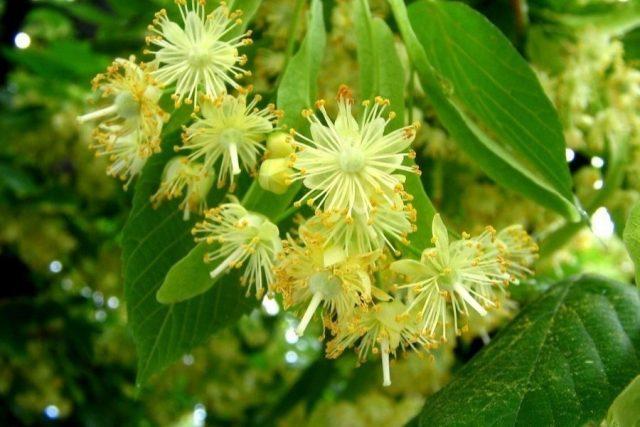
The tree is an excellent honey plant; during flowering it emits a pleasant sweetish-honey aroma, pronounced but not cloying.
Linden growth rate
The growth rate of large-leaved linden is quite high. Over the course of a season, in more or less favorable conditions, the tree adds 40-50 cm in height. The crown diameter increases by 30-35 cm.
Where does it grow
The natural habitat of the large-leaved linden includes almost all of Europe - Western, Central and Southern. It successfully adapts to both Mediterranean and temperate climates. The tree also grows in the territory of the former USSR - in Ukraine, Moldova, in the states of the Caucasus and Transcaucasia.In Russia, large-leaved linden has successfully adapted to climatic conditions in the middle zone; cold resistance allows it to climb approximately to the latitude of St. Petersburg.
Attitude to light
Large-leaved linden is a light-loving tree that adapts to light partial shade. Direct sunlight throughout the day is undesirable for it - burns remain on young leaves.
In dense shade, it will not die either, but with a lack of light, the growth rate slows down greatly, the shoots become deformed, and the leaves become smaller. The tree becomes more susceptible to any negative external influences.
Varieties of large-leaved linden
Large-leaved linden is a fairly popular crop among breeders. Its most popular varieties:
- Fastigiata. The trunk is columnar, the crown is narrow pyramidal. The leaves are oval, with a pointed tip, and change color to golden lemon in the fall. Flowering occurs at the end of June. Large spherical red-brown fruits do not fall from the branches in winter.
Large-leaved linden Fastigiata is distinguished by its endurance: it can survive extreme cold
- Rubra. The height of the tree is 30-35 m. The crown is dense, of an unusual pyramidal-cubic shape. The leaves are almost round, about 10 cm long and in diameter. The flowers are large (up to 1.5 cm), lemon yellow.
Large-flowered linden Rubra is demanding on the quality of the soil - it definitely needs a fertile, loose substrate
- Rathaus. Tree 23-25 m high. The crown is narrow, columnar, 6-8 m in diameter. The leaves are large, very dark green, with pronounced veins. Only the opened leaf blades are pinkish.
Large-leaved linden Rathaus tolerates both deficiency and excess moisture better than its relatives
- Aurea. Reaches a height of 20-25 m. Does not tolerate even light partial shade. The crown is pyramidal, and as the tree grows it becomes spreading and tent-shaped. The flowers are yellow-beige, the buds open in June-July.
The leaves, buds, flowers, and fruits of the large-leaved linden Aurea are larger than those of the natural variety
- Orebro. The height is within 17-20 m. The crown is quite narrow, cone-shaped. The leaves are heart-shaped, 10-12 cm long. The flowers are large, bright yellow, and very actively secrete nectar.
Large-leaved linden Orebro takes root in regions with harsher than temperate climates due to its high frost resistance
- Celzat. The height is no more than 20 m, the crown is very dense, cone-shaped. The leaves are almost round, 12-14 cm long. The tree is capable of
Pest attack for large-leaved linden Celsate is an exceptional phenomenon
- Tortuosa. Tree up to 20 m high. The crown is dense, wide-pyramidal. The leaves are bright green, 13-15 cm long and diameter. The flowers are beige-yellow.
Large-leaved linden Tortuosa has good drought and cold resistance
- Laciniata. Grows up to 18-20 m in height. The crown is sparse, even openwork, pyramidal. Leaves are unevenly dissected. The flowers are large, yellowish.
If you provide the large-leaved linden Laciniata with good lighting, it can adapt to waterlogged soil
Advantages and disadvantages
In terms of cold resistance, large-leaved linden belongs to USDA zone 5. It is capable of overwintering without loss or with minimal damage at temperatures ranging from -23.4 to 28.8 °C.
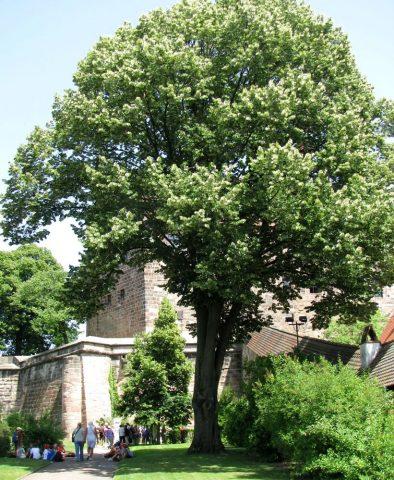
Almost all parts of the tree - bark, leaves, flowers, fruits - are actively used in folk medicine
Pros:
- decorative throughout the year;
- abundant flowering and pleasant aroma of flowers;
- pronounced melliferous properties;
- wide possibilities of use in landscape design;
- ease of care;
- ability to easily tolerate haircut;
- rare cases of damage by diseases and pests;
- high growth rates;
- long life expectancy;
- ability to adapt to dusty and polluted city air;
- noise and dust absorption properties.
Minuses:
- love of light;
- demands on soil quality;
- insufficient cold resistance for many Russian regions.
Landing rules
The place for planting large-leaved linden is selected taking into account the following criteria:
- an open area, well lit and warmed by the sun;
- a substrate that combines fertility with looseness, provides normal aeration and does not create prerequisites for stagnation of water at the roots;
- neutral or slightly acidic soil pH (6.5-7.0);
- groundwater lying at least 2 m below ground level;
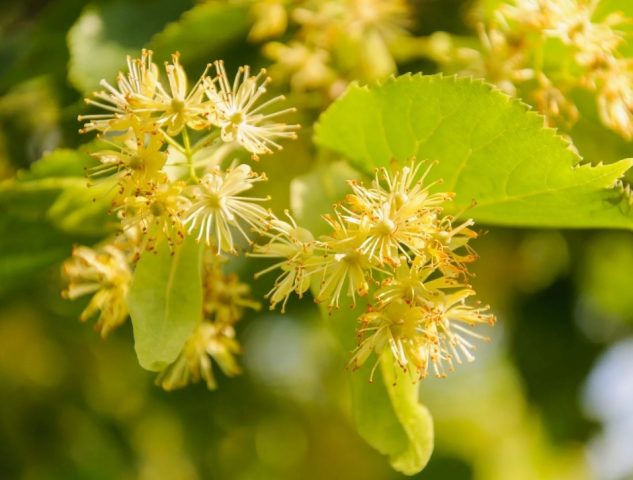
With a lack of light, normal tree growth and development is impossible
Large-leaved linden can be planted both in spring and autumn; specimens with a closed root system can be planted throughout the entire active growing season. For spring planting, the planting hole is prepared last season, for autumn planting - 15-20 days before the procedure. Approximate depth and diameter – 50-60 cm.
At the bottom, a layer of drainage 12-15 cm thick is required. Fertile soil is poured on top, filling the hole by about a third.
The procedure is standard for any fruit-bearing or ornamental tree: before and after planting, the soil must be well watered, then the trunk circle must be mulched.In the process, they monitor the position of the roots, preventing them from bending up and to the sides and the root collar, leaving it above the surface of the earth.
Care instructions
Caring for large-leaved linden takes a minimum of time and effort:
- Watering. In the first season after planting, the trees are watered so that the substrate is constantly moderately moist. Mature large-leaved linden trees often survive on natural precipitation throughout the entire season. But if hot and dry weather persists for a long time, it is recommended to water the tree once every 5-7 days.
- Feeding. Fertilizers are applied three times a season: at the beginning - nitrogen-containing fertilizer, about a month before frost - phosphorus-potassium fertilizer. 2-3 weeks after flowering, large-leaved linden is fed with any complex preparation for ornamental garden trees.
- Mulching. Even adult specimens, not to mention young seedlings, do not tolerate being close to weeds well. Mulch helps save time on weeding the large-leaved linden tree trunk. In addition, it retains moisture in the soil and allows you to do without loosening.
- Trimming. Starting from the second year after planting, sanitary pruning is carried out at the beginning and end of the season, and the crown is thinned out as necessary. If desired, in the spring it can be combined with shaping - large-leaved linden tolerates pruning, even radical, well and recovers quickly.
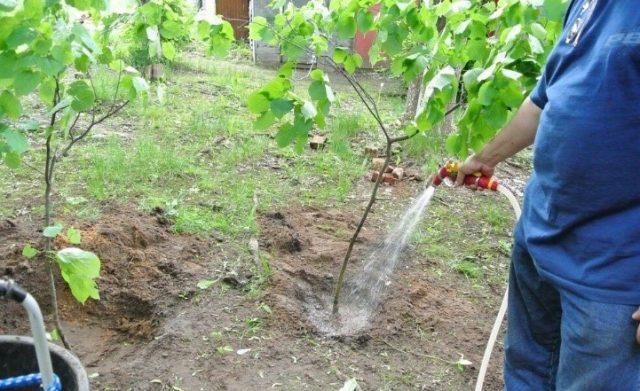
Approximate water consumption for irrigation is 15-20 liters per 1 m² of tree trunk circle
Pest and disease control
Typical of other ornamental trees, large-leaved linden is rarely affected. However, there is an infectious disease specific to it - thyrostromosis. It is dangerous for trees if you plant them without taking into account the requirements of the culture and/or completely abandon them, leaving them without care.
Large-leaved linden affected by thyrostromosis gradually dries out. The leaves become smaller, become coarser, become leathery to the touch, curl into a tube, the crown thins, and the trunk cracks.
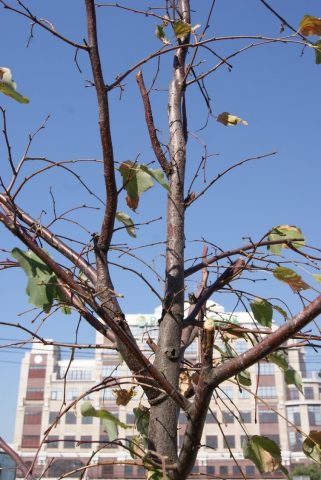
The growth of an infected tree practically stops; it dies within 3-4 seasons
Having discovered characteristic symptoms, all affected shoots are pruned. Then treat the large-leaved linden and the soil in the trunk circle with a solution of any fungicide, using it strictly according to the instructions.
Among the pests on large-leaved linden you can find:
- scale insect;
- different types of leaf rollers;
- gall mites;
- leaf-eating caterpillars.
Suitable insecticides are used to control them. If the tree is not tall, it is advisable to first give it a shower and collect all visible pests.
Reproduction methods
New specimens of large-leaved linden can be obtained both vegetatively and generatively. However, seed propagation is not suitable for breeder-bred varieties. Seedlings do not always inherit the varietal characteristics of their parents.
In general, propagation of large-leaved linden by seeds is a long process, so it is not often used.Planting material definitely needs six-month stratification.
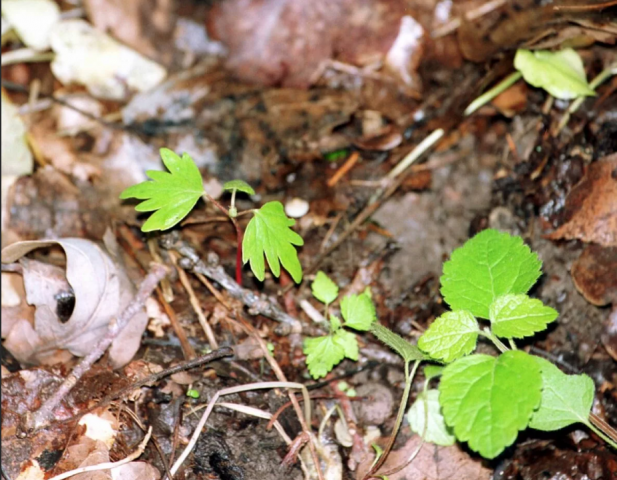
The seeds cannot boast of high germination rate; they do not germinate quickly
The simplest methods are propagation by cuttings or layering. The first ones are cut in late spring or early summer and planted in any moisture-intensive substrate, providing warmth and a greenhouse effect. Rooting lasts for 6-8 weeks.
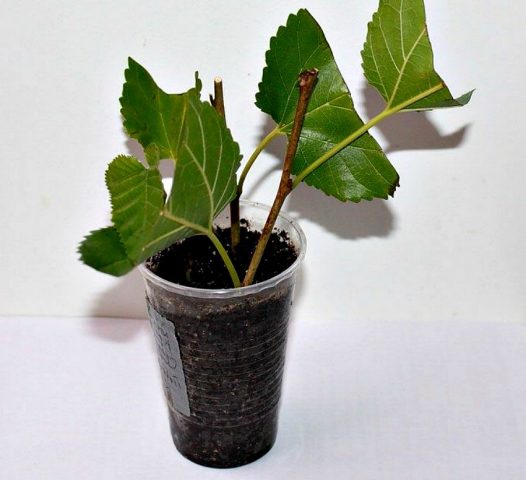
New specimens of large-leaved linden can be planted in open ground in a year or next fall
Photos in landscape design
Due to its large size, large-leaved linden becomes the main accent in any landscape composition. She is not picky about companions.
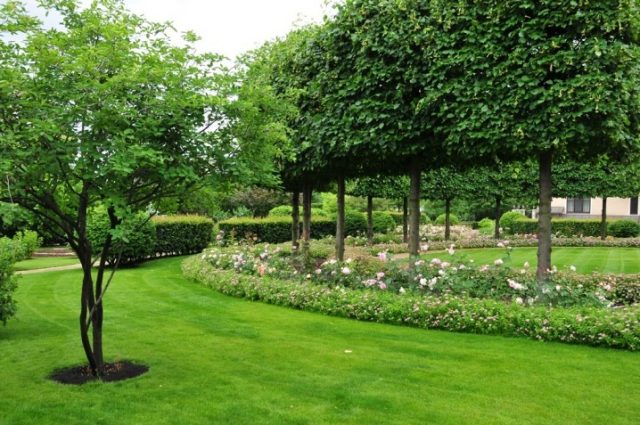
The easiest option is to use large-leaved linden to decorate a recreation area
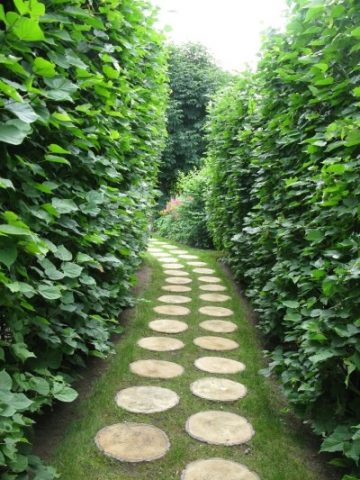
A neatly trimmed green wall will be a suitable design for an alley, path, or effective protection from dust and wind.
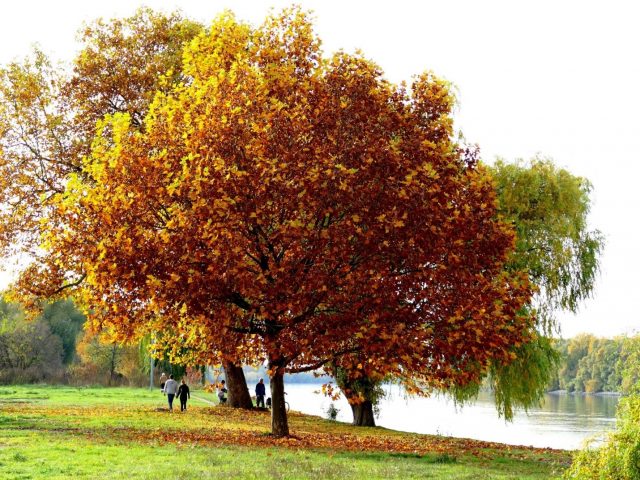
In autumn, the juxtaposition of large-leaved linden with maple, beech or rowan looks very bright and impressive

Combining business with pleasure, large-leaved linden trees are planted in apiaries
Conclusion
Natural large-leaved linden and its selectively bred varieties successfully combine decorative properties with undemanding requirements for agricultural technology and cultivation conditions, and good resistance to diseases and pests. Despite its size, the tree is used not only for landscaping urban areas, but also for planting on personal plots.
